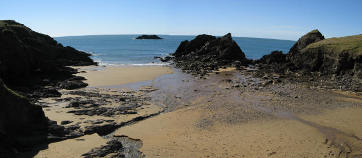2015
SALCOMBE AT WAR 1939-45 -- Roger Barrett
It was practically standing room only at Malborough History Group’s October meeting, when Roger Barrett treated us to his talk on “Salcombe at War 1939-45”.
There were some very interesting facts and figures; for instance it was amazing to learn that the Salcombe area received 900 child evacuees. The United States Navy moved into Salcombe in 1943, prepared a flotilla of 66 vessels for the D-Day landings and remained in the town until the end of the war repairing landing craft. The Salcombe Hotel became their headquarters and a few sleep-deprived locals complained about the National Anthem being broadcast at dawn and dusk. Cliff House served as a mess and recreation/training area and 60 other properties were requistioned for accommodation, workshops and stores, as well as Quonset huts being built on the hill near the Rugby Club. Local traffic was chaotic, especially as the Americans tended to drive on the wrong side of the road!
There were photographs of Mill Bay, where a slipway was constructed, and of Whitestrand, which was created by the demolition of two rows of derelict houses. Both sites were used for the repair and maintenance of US Navy landing craft. Roger showed us a wonderful piece of film, recently discovered on YouTube sandwiched between two gangster movies, which included footage of practice landings on Fishermen’s Cove and US Navy boats out in the estuary. When the Americans left, the people of Salcombe were officially thanked for their ‘warmth and co-operation’.
While we enjoyed our refreshments afterwards, we were able to peruse files full of research information and WW2 related material, including some fascinating WVS records.
Roger has just written a new book, “The Salcombe Lifeboat Disaster”, and he has kindly agreed to come back to the History Group next October, the month when the centenary of the disaster will be commemorated, to tell us all about it.
VILLAGE WALKABOUT -- John Cole
The History Group’s June meeting, on a glorious sunny evening, saw John Cole leading a large group of people (and a dog!) round the village and regaling them with history and anecdotes about the buildings, the church and the vagaries of Malborough life through the centuries. John has lived in the village all his life and his insights and stories added up to a fascinating evening, rounded off by refreshments in the church and a short history of the Village Hall by Brian Taylor.
A couple of weeks later, we took part in Malborough Village Fete, a fantastic family affair, where we mounted an exhibition of around 75 old photographs, which provoked much interest and many fond reminiscences.
ARCHAEOLOGICAL FINDS FROM DEVON -- Danielle Wootton
On April 1, the History Group welcomed back Danielle Wootton, Devon Finds Liaison Officer for the Portable Antiquities Scheme. The Scheme, with headquarters at the British Museum, is a government-funded project, encouraging the voluntary recording of archaeological objects found by members of the public.
Danielle showed us photographs and details of various finds from the South West, from a ten thousand year old microlith (small flint tool), Roman beads and jewellery, to pointed ridge tiles, so shaped to ward off witches and evil spirits. Examples of items found in Malborough itself were a C14 ‘Long Cross Penny’ and a C18 or C19 leather worker’s or sailmaker’s palm guard.
We were also given an up-date of work at the Ipplepen dig, featured on BBC’s “Digging for Britain”, which includes a Roman road and associated late and post-Roman cemetery. A significant number of Roman coins have been uncovered, along with an Iron Age roundhouse and further Romano-British features, and it is considered one of the most significant Romano-British sites discovered in Devon, with huge potential to develop our understanding of settlements and how people lived in the South West 2,000 years ago.
Danielle is a knowledgeable and enthusiastic speaker and it was a fascinating evening.
DEVON PLACE NAMES -- Robert Hesketh
Every Devon place name has a story to tell, usually a very old story going back well over a thousand years to the Saxon settlement. They reflect successive layers of conquest and settlement, revealing a great deal about our ancestors, the languages they spoke, their names and the lives they led.
At their February meeting, the Malborough History Group welcomed local writer and photographer, Robert Hesketh, to give an illustrated talk on the subject, focussing on the key aspects of place name study and specifically place names in Devon. He outlined the origin and evolution of Devon place names and gave an explanation of common place name elements such as ton, ford, leah and ham, while his slides showed how place names relate to the landscape.
Previous reports

